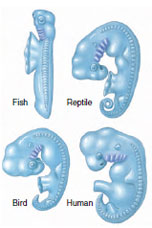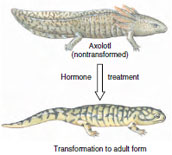Ontogeny, Phylogeny, and Recapitulation
Ontogeny, Phylogeny, and
Recapitulation
Ontogeny is the history of the development of an organism through its entire life. Early developmental and embryological features contribute greatly to our knowledge of homology and common descent. Comparative studies of ontogeny show how the evolutionary alteration of developmental timing generates new characteristics, thereby producing evolutionary divergence among lineages.
The German zoologist Ernst Haeckel, a contemporary of Darwin, believed that each successive stage in the development of an individual represented one of the adult forms that appeared in its evolutionary history. The human embryo with gill depressions in the neck was believed, for example, to resemble the adult appearance of a fishlike ancestor. On this basis Haeckel gave his generalization: ontogeny (individual development) recapitulates (repeats) phylogeny (evolutionary descent). This notion later became known simply as recapitulation or the biogenetic law. Haeckel based his biogenetic law on the flawed premise that evolutionary change occurs by successively adding new features onto the end of an unaltered ancestral ontogeny while condensing the ancestral ontogeny into earlier developmental stages. This notion was based on Lamarck’s concept of the inheritance of acquired characteristics.
The nineteenth-century embryologist,
K. E. von Baer, gave a more satisfactory
explanation of the relationship
between ontogeny and phylogeny. He
argued that early developmental features
were simply more widely shared
among different animal groups than
later ones. Figure 6-16 shows, for
example, the early embryological similarities
of organisms whose adult forms
are very different (see Figure 8-19) The adults of animals with relatively
short and simple ontogenies
often resemble pre-adult stages of
other animals whose ontogeny is more
elaborate, but embryos of descendants
do not necessarily resemble the adults
of their ancestors. Even early development
undergoes evolutionary divergence
among lineages, however, and it
is not quite as stable as von Baer
believed.
We now know that there are many parallels between ontogeny and phylogeny, but
features of an ancestral
ontogeny can be shifted either to earlier
or later stages in descendant ontogenies.
Evolutionary change in timing of
development is called heterochrony,
a term initially used by Haeckel to
denote exceptions to recapitulation. If a
descendant’s ontogeny extends beyond
its ancestral one, new characteristics
can be added late in development,
beyond the point at which development
would have terminated in
the evolutionary ancestor. Features
observed in the ancestor often are
moved to earlier stages of development
in this process, and ontogeny therefore
does recapitulate phylogeny to some
degree. Ontogeny also can be shortened
during evolution, however. Terminal
stages of the ancestor’s ontogeny
may be deleted, causing adults of
descendants to resemble pre-adult
stages of their ancestors (Figure 6-17).
This outcome reverses the parallel
between ontogeny and phylogeny (reverse
recapitulation) producing paedomorphosis
(the retention of ancestral
juvenile characters by descendant
adults). Because lengthening or shortening
of ontogeny can change different
parts of the body independently,
we often see a mosaic of different
kinds of developmental evolutionary
change in a single lineage. Therefore,
cases in which an entire ontogeny
recapitulates phylogeny are rare.
Ontogeny is the history of the development of an organism through its entire life. Early developmental and embryological features contribute greatly to our knowledge of homology and common descent. Comparative studies of ontogeny show how the evolutionary alteration of developmental timing generates new characteristics, thereby producing evolutionary divergence among lineages.
The German zoologist Ernst Haeckel, a contemporary of Darwin, believed that each successive stage in the development of an individual represented one of the adult forms that appeared in its evolutionary history. The human embryo with gill depressions in the neck was believed, for example, to resemble the adult appearance of a fishlike ancestor. On this basis Haeckel gave his generalization: ontogeny (individual development) recapitulates (repeats) phylogeny (evolutionary descent). This notion later became known simply as recapitulation or the biogenetic law. Haeckel based his biogenetic law on the flawed premise that evolutionary change occurs by successively adding new features onto the end of an unaltered ancestral ontogeny while condensing the ancestral ontogeny into earlier developmental stages. This notion was based on Lamarck’s concept of the inheritance of acquired characteristics.
 |
| Figure 6-16 Comparison of gill arches of different embryos. All are shown separated from the yolk sac. Note the remarkable similarity of the four embryos at this early stage in development. |
We now know that there are many parallels between ontogeny and phylogeny, but
 |
| Figure 6-17 Aquatic and terrestrial forms of axolotls. Axolotls retain the juvenile, aquatic morphology (above) throughout their lives unless forced to metamorphose (below) by hormone treatment. Axolotls evolved from metamorphosing ancestors, an example of paedomorphosis. |




